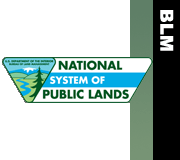|
Print Page | |||||||||||
Federal LawsThe Federal Land Policy and Management Act (FLPMA) – FLPMA is the organic act that provides overall legislative direction to the BLM for all its management activities and responsibilities. Specific sections that pertain to BLM’s travel and transportation responsibilities include:
The National Trails System Act – Institutes a national system of recreation, scenic and historic trails. It also prescribes the methods and standards through which additional components may be added to the system. Safe, Accountable, Flexible, Efficient Transportation Equity Act: A Legacy for Users (SAFETEA-LU) – SAFETEA-LU authorizes the Federal surface transportation programs for highways, highway safety, and transit for 5 years (2005-2009). The Transportation Equity Act for the 21st Century (TEA-21) – TEA-21 (1998, PL 105-178) authorizes the Federal surface transportation programs for highways, highway safety, and transit for the 6-year period 1998-2003. The Intermodal Surface Transportation Efficiency Act (ISTEA) – ISTEA (1991) provides policy for various transportation enhancement activities, National Scenic Byways, and the National Highway System. National Environmental Policy Act of 1969 (NEPA) – NEPA (PL 91-190, 83 Stat. 852) requires that certain federal projects and land use decisions include prescribed environmental review. The Wilderness Act of 1964 – Among other things, the Wilderness Act (Public Law 88-577) generally prohibits the use of motor vehicles in wilderness. The law contains special provisions for motor vehicle use when required in emergencies or as necessary for the administration of the area. Motor vehicles may also be permitted for special uses such as access to a private inholding, to support grazing, or to exercise valid existing rights. Executive OrdersExecutive Orders 11644 and 11989 were issued in the 1970s to established policies and procedures for regulating the use of off-highway (aka: off-road) vehicles of federal lands. Executive Order 11644 – Issued in February 1972 to establish policies and provide for procedures to control and direct the use of OHVs on Federal lands to: 1) protect the resources of those lands; 2) promote the safety of all users of those lands; and 3) minimize conflict between the use of OHVs and other types of recreation. The order closes wilderness and primitive areas to OHV use. It also requires the federal agencies to issue OHV use regulations, inform the public of the lands’ designation for OHV use through signs and maps, enforce OHV use regulations, and monitor the effects of OHV use of the land. Executive Order 11989 – Issued in May 1977 and contains three amendments to Executive Order 11644. While these amendments lifted restrictions on the use of military and emergency vehicles on public lands during emergencies, they otherwise strengthened protection of the lands by authorizing agency heads to: 1) close areas or trails to OHVs causing considerable adverse effects; and 2) designate lands as closed to OHVs unless the lands are specifically designated as open to them. RegulationsThe BLM developed regulations in response to applicable Federal laws and Executive Orders. These regulations require the BLM to designate areas where OHVs may be used and to manage the use of OHVs; to identify any adverse effects of OHV use; and to take appropriate steps to counteract such effects. Specific BLM travel management-related regulations include the following:
BLM Strategic Action PlansThe following BLM Strategic Action Plans provide additional travel and transportation guidance. BLM’s National Management Strategy for Motorized Off-Highway Vehicle Use On Public Lands – Released in 2001, this Strategy is aimed at recognizing the interests of motorized OHV users while protecting environmentally sensitive areas on the public lands. The Strategy also seeks to focus the agency's resources on motorized OHV management on-the-ground (ie, at the local Field Office level). National Mountain Bicycling Strategic Action Plan –This Action Plan aims to facilitate providing high-quality mountain bicycling experiences on BLM-managed public lands. The Plan provides guidance for implementing resource protection measures for mountain bicycling use and other human-powered mechanical transport. November 2002. National Scenic & Historic Trails Strategy & Work Plan – The National Trails System Act of 1968 directed the BLM and other Federal agencies to achieve certain objectives and purposes for the development of the National Trail System. BLM’s National Scenic & Historic Trails Strategy provides a 10-year framework for the development of program guidance and direction for improved management of BLM’s National Scenic and Historic Trails program. Additional BLM Travel Management Policy Documents & Technical ReferencesBLM Roads and Trails Terminology Report – Provides BLM recommendations concerning the management of transportation-related linear features on public lands, including using a standard terminology, data management, data dictionary, and alignment of programs responsible for travel management functions. Interim Management Policy for Lands Under Wilderness Review, H-8559-1 – Contains specific direction on how BLM manages travel and transportation in areas found suitable for wilderness designation pending a final decision by Congress as to whether or not they should be included in the National Wilderness Preservation System. BLM Land Use Planning Handbook / Travel Management – This Handbook includes a section which requires BLM land use plans to delineate travel management areas and designated OHV management areas (H-1601-1; Appendix C, Section D). Other BLM Travel Management Manuals & Handbook Guidance – BLM’s directives system is comprised of individual Manuals and Handbooks for transmitting policy and instructions for travel management and related visitor services. (Most of this guidance is not available via the Internet; however, as new manuals and handbooks are developed they will be available electronically.) |
||||||||||||






